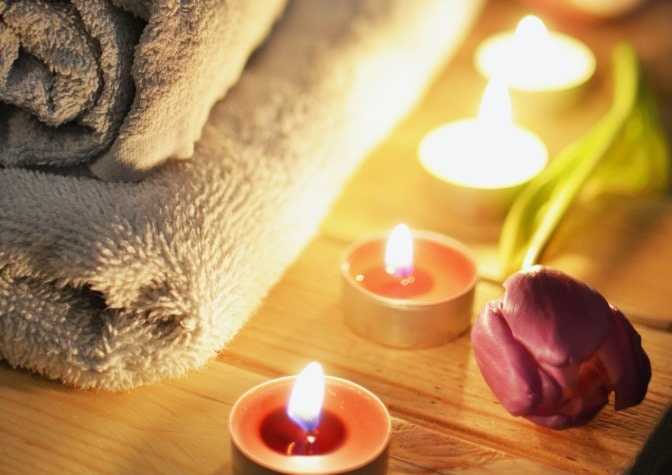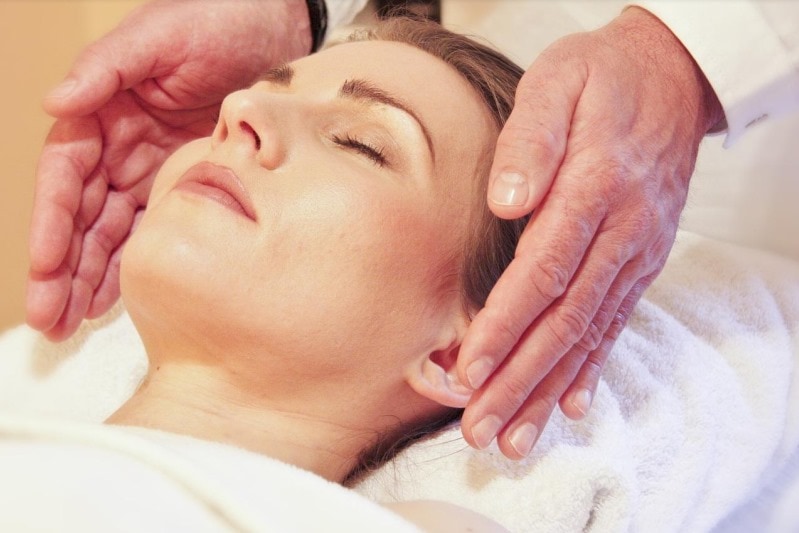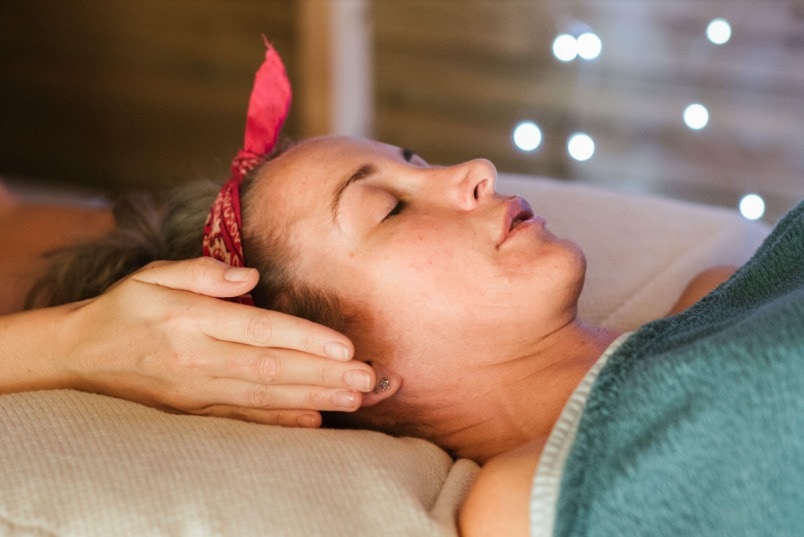So what is Reiki? Reiki is a complementary therapy practiced as alternative medicine that naturally boosts your body’s natural healing abilities. It originates from Japan, where Dr. Mikao Usui developed it during the early 1900s.
While Reiki therapy does not directly cure or treat illnesses, its purpose is to manage the severity of chronic symptoms while promoting wellness and balance and improving your body’s immunity response.
What to Expect During a Reiki Session
A Reiki healing session typically begins in a calming, relaxing environment, with soft music or sounds, aromatherapy, and dim lighting. You can expect the session to last between twenty minutes and one hour.
Reiki is practiced on another person by a certified Reiki practitioner in standing or sitting. The practitioner’s hands are placed above certain parts of your body to stimulate natural healing abilities.
Preparing for Your First Reiki Treatment
Before you begin your first Reiki session, you’ll meet for a consultation with your Reiki practitioner to discuss how the process works, what to expect, and how to set your intentions for each session.
For example, you may suffer from chronic headaches, and you aim to release tension for more significant relief. If you have any injuries or chronic pain, it’s best to discuss these matters with your Reiki therapist to ensure they handle these areas with sensitivity during a session.
Reiki treatment is typically performed as you lie on a comfortable mat or table with a blanket or cushion. You can decide if you prefer a blend of essential oils as a part of your session or relaxing music to bring about relaxation.
Consulting with a practitioner can help prepare you to get the most out of each Reiki treatment so that you can enjoy the comfort and benefit during the session.
When you attend your first Reiki session, it’s essential to wear loose, comfortable clothing with natural fabrics so that you don’t feel restricted during a Reiki practice.
The best natural fabrics to wear include silk, cotton, or linen, which are breathable materials. Your socks should be comfortable, your shoes removed, and any loose jewelry, accessories, and glasses should be. Remove any distractions, such as your phone, so you can fully gain the most out of your Reiki session.
Your First Reiki Experience
As the Reiki practitioner begins, they will position their hands over your body, with either a light or no touch, while maintaining proximity to stimulate your body’s healing abilities.
Initially, you can expect different sensations throughout your body, including tingling or heat in the areas where the Reiki energy is focused. You may experience other sensations, such as bold visualizations in your mind or vivid memories.
Allowing these experiences to pass and not ruminating or fixing on them is essential during these instances. You may feel tired, calm, or rejuvenated. Drinking plenty of water and resting after a Reiki treatment is essential, and you may also find that rest after a session is beneficial.

Training for Reiki
There are three levels of training in Reiki, each of which concentrates on learning about the history of this alternative therapy, specific healing practices, and how to give Reiki to someone or attune them for energy.
The first level, Reiki I, or the entry level, is also known as Shoden in Japanese. At this stage, you’ll learn about the history of this practice, specifically Usui Reiki, and how to become initiated or attuned to receive and use energy.
The second level or degree, Reiki II, concentrates on providing instruction on using the first three Reiki symbols and performing these techniques.
During this stage, also known as Okuden, you’ll receive Reiki attunements, and once the class is completed, the result is becoming a Reiki practitioner.
The third and final level is Reiki Master, or Reiki III, which is often separated into two sections; one concentrates on learning the Master Reiki symbol, while the other is how to give Reiki attunements. This level is also called Shinpiden.
When you choose a Reiki practitioner, it’s essential to understand the levels of training for Reiki professionals and what they can offer you with their knowledge, energy, and experience.

The Benefits of Reiki Treatments
Reiki offers many benefits through energy healing and working with your body to relieve pain and reduce fatigue, anxiety, and stress. Some studies support the improvement of mood and overall well-being in people who suffer from depression and chronic illnesses.
Relief from Depression and Related Symptoms
Reiki research indicates that a regular treatment plan can alleviate some signs of depression, especially in older adults who may also experience anxiety and recurring pain.
Some positive effects include a greater sense of ease, a more relaxed state, and improved focus. Reiki is an excellent method of self-care that can boost your mental health and provide stress reduction when applied consistently.
While the results may vary for each individual, Reiki treatments generally relax the mind and body, so you’ll often feel refreshed after each session.
Easing Anxiety, Stress, and Pain
It’s common to feel more stressed and anxious when experiencing chronic pain or other health-related challenges. Reiki and massage treatments have greatly reduced pain and fatigue in people treated for cancer and other serious conditions.
While Reiki doesn’t directly heal or treat these medical conditions, treatments can alleviate some of the pain and stress they cause. Reiki therapy is often offered as a complementary treatment for cancer patients at hospitals or clinics, where they receive medical treatments and assessments.
Reiki has also been shown to lower blood pressure and ease the pain after a cesarean delivery, which can help boost the effects of medical treatments.
Lower back pain, joint stiffness, and other chronic ailments can benefit from regular, thirty-minute Reiki sessions performed routinely. You may also find longer sessions, up to one hour, can enhance Reiki’s effects on your body and mind.
Lifts Mood and Promotes Deep Relaxation
Many people experience a sense of peace and deeper relaxation following a Reiki treatment. It may take several sessions to feel the full effects of this outcome, though generally, Reiki offers a clearer mind and a sense of calm that helps improve your mood after several weeks of treatments.
Improves Your Quality of Life
If you have difficulty sleeping or enjoying life due to mounting stress and challenges, Reiki can help your mind and body pause, so you have time to relax, realign your thoughts and goals, and enhance your quality of life.
Some people have experienced a boost in their self-confidence and sleeping patterns, with a more profound sense of inner peace. Practicing meditation is another way to boost the impact of Reiki treatments in easing your mind and reducing stress.
Are There Any Side Effects When Practicing Reiki?
Reiki is generally safe, and there are no known harmful side effects. If you feel uncertain about trying the practice because the idea of receiving Reiki treatment from someone you’re unfamiliar with makes you anxious, meeting with your Reiki practitioner can help alleviate your worries.
Individuals who have endured past trauma, or find specific spaces triggering, such as a dimly lit room, can discuss which changes will make them more comfortable and relaxed during a Reiki session.
It’s important to consider that while Reiki is a valuable complementary treatment, it cannot replace traditional medicine or treatments provided by a physician or medical specialist.
Reiki is meant to supplement healthy eating, exercise, meditation, medical treatments, and other ways to improve and support good health.
Ideally, Reiki is a natural healing process that works best as a preventative treatment to enhance your ability to reduce the likelihood of anxiousness and respond well to stressful situations to prevent ill effects on your health and well-being.
Reiki sessions can also boost your body’s ability to respond to traditional medicine and experience less severe side effects, which can improve your life.
Final Thoughts
Reiki is a wonderful practice that soothes the mind and body. If you’re already in good health, you’ll find that routine Reiki treatment can enhance your overall well-being so that you’re less reactive to stressful situations and feel more at ease.
Reiki is a powerful but gentle preventive medicine that can also treat mild symptoms, including headaches, tension, nausea, stress, and insomnia.
When you experience Reiki for the first time, you may feel different sensations, such as tingling or heat in some regions of your body, which are the effects of energy healing or activating areas in your body to boost your natural life force or healing abilities. At first, these sensations may seem unusual or new, though you’ll soon feel the positive effects with every treatment.
You’ll soon find that these sensations alleviate some, if not all, of the tension in your body while putting your mind at ease. Reiki is an excellent practice to learn, whether your goal is to become a practitioner or Reiki Master or simply use the techniques on yourself for more remarkable healing.

